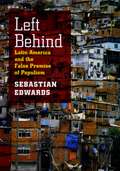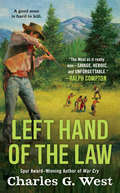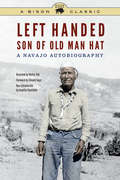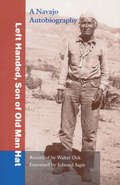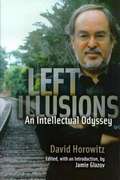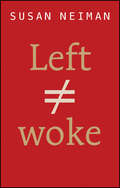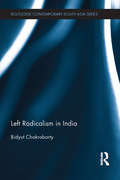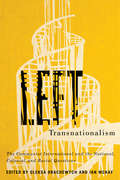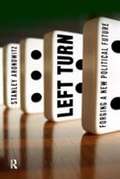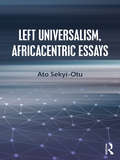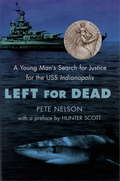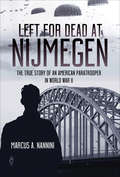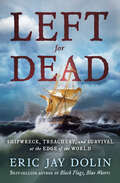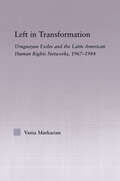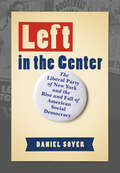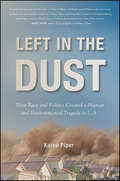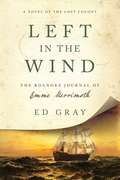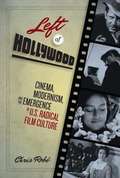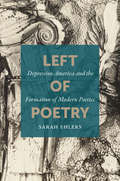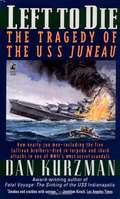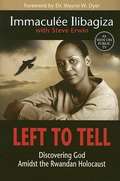- Table View
- List View
Left Behind: Latin America and the False Promise of Populism
by Sebastian EdwardsThe political and economic history of Latin America has been marked by great hopes and even greater disappointments. Despite abundant resources--and a history of productivity and wealth--in recent decades the region has fallen further and further behind developed nations, surpassed even by other developing economies in Southeast Asia and elsewhere. In Left Behind, Sebastian Edwards explains why the nations of Latin America have failed to share in the fruits of globalization and forcefully highlights the dangers of the recent turn to economic populism in the region. He begins by detailing the many ways Latin American governments have stifled economic development over the years through excessive regulation, currency manipulation, and thoroughgoing corruption. He then turns to the neoliberal reforms of the early 1990s, which called for the elimination of deficits, lowering of trade barriers, and privatization of inefficient public enterprises--and which, Edwards argues, held the promise of freeing Latin America from the burdens of the past. Flawed implementation, however, meant the promised gains of globalization were never felt by the mass of citizens, and growing frustration with stalled progress has led to a resurgence of populism throughout the region, exemplified by the economic policies of Venezuela's Hugo Chávez. But such measures, Edwards warns, are a recipe for disaster; instead, he argues, the way forward for Latin America lies in further market reforms, more honestly pursued and fairly implemented. As an example of the promise of that approach, Edwards points to Latin America's giant, Brazil, which under the successful administration of President Luis Inácio da Silva (Lula) has finally begun to show signs of reaching its true economic potential. As the global financial crisis has reminded us, the risks posed by failing economies extend far beyond their national borders. Putting Latin America back on a path toward sustained growth is crucial not just for the region but for the world, and Left Behind offers a clear, concise blueprint for the way forward.
Left Hand of the Law
by Charles G. WestAfter a corrupt deputy kills his family, burns his home, and leaves him with a scar across his face, Ben Cutler settles the score. The townsfolk called it justice, but the judge called it murder-and Cutler is a wanted man. He's also trailed by an obsessed marshal, a vengeful Sioux warrior, and a low-down scoundrel. While on the run, will Cutler ever find hope? .
Left Handed, Son of Old Man Hat, Bison Classic Edition: A Navajo Autobiography
by Edward Sapir Left Handed Walter Dyk Jennifer DenetdaleWith a simplicity as disarming as it is frank, Left Handed tells of his birth in the spring of 1868 “when the cottonwood leaves were about the size of [his] thumbnail,” of family chores such as guarding the sheep near the hogan, and of his sexual awakening. As he grows older, his account turns to life in the open: nomadic cattle-raising, farming, trading, communal enterprises, tribal dances and ceremonies, lovemaking, and marriage. As Left Handed grows in understanding and stature, the accumulated wisdom of his people is revealed to him. He learns the Navajo lifeway, which is founded on the principles of honesty, foresightedness, and self-discipline. The style of the narrative is almost biblical in its rhythms, but biblical, too, in many respects, is the traditional way of life it recounts.
Left Handed, Son of Old Man Hat: A Navaho Autobiography
by Edward Sapir Left Handed Walter DykWith a simplicity as disarming as it is frank, Left Handed tells of his birth in the spring "when the cottonwood leaves were about the size of my thumbnail," of family chores such as guarding the sheep near the hogan, and of his sexual awakening. As he grows older, his account turns to life in the open: nomadic cattle-raising, farming, trading, communal enterprises, tribal dances and ceremonies, lovemaking, and marriage. As Left Handed grows in understanding and stature, the accumulated wisdom of his people is made known to him. He learns the Navajo life founded upon principles: the necessity of honesty, foresightedness, self-discipline. The style of the narrative is almost biblical in its rhythms; but biblical, too, in many respects, is the traditional way of life it recounts.
Left Illusions
by David HorowitzDavid Horowitz is one of the founding intelectuals of the American left. In the 1960's he was at the "intellectual center of the New Left" but by the 1980s he had broken with the left and become one of its most viggerous and thought provoking opponents. This book is a collection of Mr. Horowitz's writings from the mid 60's to the present showing his development from a young radical of the left to a man who completely a poses everything the left stands for. He argues that the Left Illusions have caused more death and human misery then anything else in human history. After two century's and over a hundred million deaths its time to turn away from Marks and and abandon the eutopien nightmare. Born in a communist aunclave in New York, He discribes how he changed from a "Red Diaper Baby" to a conservative. Mr. Horowitz writes "I realized that you couldn't sit everybody down and re-educate them, make them good parents and good citizens. This meant that you couldn't really remake the world as the left intended without totalitarian coercion. But it was much more difficult to accept the consequences of that realization. For a long time, I simply could not face the possibility that there was no socialist future, that I was not going to be a social redeemer, and that we didn't have the answers to humanity's problems-in short, that I wasn't part of an historic movement that would change the world." After turning away from the left, He could look back at the left and see the terrible havock which has been wrought and is still being wrought The eutopien dreams which in practice leed to the Goolag and the Iron Curtain.David Horowitz is one of the founding intellectuals of the American left. In the 1960s he was at the "intellectual center of the New Left" but by the 1980s he had broken with the left and become one of its most vigorous and thought-provoking opponents. This book is a collection of Mr. Horowitz's writings from the mid-60's to the present, showing his development from a young radical of the left to a man who completely opposes everything the left stands for. He argues that the “Left Illusions” have caused more death and human misery than anything else in human history. After two centuries and over a hundred million deaths, it’s time to turn away from Marx and abandon the utopian nightmare. Born in a communist enclave in New York, he describes how he changed from a "Red Diaper Baby" to a conservative. Mr. Horowitz writes, "I realized that you couldn't sit everybody down and re-educate them, make them good parents and good citizens. This meant that you couldn't really remake the world as the left intended without totalitarian coercion. But it was much more difficult to accept the consequences of that realization. For a long time, I simply could not face the possibility that there was no socialist future, that I was not going to be a social redeemer, and that we didn't have the answers to humanity's problems--in short, that I wasn't part of an historic movement that would change the world." After turning away from the left, he could look back at the left and see the terrible havoc which has been wrought and is still being wrought: the utopian dreams which in practice led to the Gulag and the Iron Curtain.
Left Is Not Woke
by Susan NeimanIf you’re woke, you’re left. If you’re left, you’re woke. We blur the terms, assuming that if you’re one you must be the other. That, Susan Neiman argues, is a dangerous mistake. The confusion arises because woke is fuelled by traditionally leftwing emotions: the wish to stand with the oppressed and marginalized, to address historic crimes. But those emotions are undermined by widespread philosophical assumptions with reactionary sources. As a result, wokeism conflicts with ideas that have guided the left for more than 200 years: a commitment to universalism, a firm distinction between justice and power, and a belief in the possibility of progress. Without these ideas, the woke will continue to undermine their own goals and drift, inexorably and unintentionally, towards the right.One of the world’s leading philosophical voices, Neiman calls with passion and power for the left to return to the ideals that built the best of the modern world.
Left Radicalism in India (Routledge Studies in South Asian Politics)
by Bidyut ChakrabartyLeft radicalism in India was rooted in the nationalist movement and was set in motion in the 1920s with the formation of the communist party. The communist movement manifested itself differently in each phase of India’s political history and Communism continues to remain a meaningful alternative ideological discourse in India. This book examines left politics in India focusing on its rise, consolidation and relative decline in the present century. Left radicalism in India is a distinct ideological phenomenon which is articulated in two complementary ways: while the parliamentary left remains social democratic in character, its bête noire, the left wing extremists, continue to uphold the classical Marxist, Leninist and Maoist notion of violent revolution. By concentrating on the nature and also activities of these two versions of left radicalism, this book is a thorough study of the phenomenon. The author analyses the states of Kerala, West Bengal and Tripura and presents a variety of case studies of communist movements. He argues that the political power of the left parties depends on the degree to which they have built organizational strength, political hegemony and a broad social base through legal and extra-parliamentary struggles. An in-depth study of socio-economic circumstances that remain critical in conceptualizing radical extremism, Left Radicalism in India will be of interest to those studying Indian Politics, South Asian History, Development Studies and Global Politics.
Left Transnationalism: The Communist International and the National, Colonial, and Racial Questions (Rethinking Canada in the World #4)
by Ian McKay Oleksa DrachewychIn 1919, Bolshevik Russia and its followers formed the Communist International, also known as the Comintern, to oversee the global communist movement. From the very beginning, the Comintern committed itself to ending world imperialism, supporting colonial liberation, and promoting racial equality. Coinciding with the centenary of the Comintern's founding, Left Transnationalism highlights the different approaches interwar communists took in responding to these issues. Bringing together leading and emerging scholars on the Communist International, individual communist parties, and national and colonial questions, this collection moves beyond the hyperpoliticized scholarship of the Cold War era and re-energizes the field. Contributors focus on transnational diasporic and cultural networks, comparative studies of key debates on race and anti-colonialism, the internationalizing impulse of the movement, and the evolution of communist platforms through transnational exchange. Essays further emphasize the involvement of communist and socialist parties across Canada, Australia, India, China, Japan, Southeast Asia, Latin America, South Africa, and Europe. Highlighting the active discussions on nationality, race, and imperialism that took place in Comintern circles, Left Transnationalism demonstrates that this organization – as well as communism in general – was, especially in the years before 1935, far more heterogeneous, creative, and unpredictable than the rubber stamp of the Soviet Union described in conventional historiography. Contributors include Michel Beaulieu (Lakehead University), Marc Becker (Truman State University), Anna Belogurova (Freie Universitat Berlin), Oleksa Drachewych (University of Guelph), Daria Dyakonova (Université de Montréal), Alastair Kocho-Williams (Clarkson University), Andrée Lévesque (McGill University), Lars T. Lih (Independent Scholar), Ian McKay (McMaster University), Sandra Pujals (University of Puerto Rico), John Riddell (Ontario Institute of Studies in Education), Evan Smith (Flinders University), S.A. Smith (All Souls College, Oxford), Xiaofei Tu (Appalachian State University), and Kankan Xie (Peking University).
Left Transnationalism: The Communist International and the National, Colonial, and Racial Questions (Rethinking Canada in the World #4)
by Ian McKay Oleksa DrachewychIn 1919, Bolshevik Russia and its followers formed the Communist International, also known as the Comintern, to oversee the global communist movement. From the very beginning, the Comintern committed itself to ending world imperialism, supporting colonial liberation, and promoting racial equality. Coinciding with the centenary of the Comintern's founding, Left Transnationalism highlights the different approaches interwar communists took in responding to these issues. Bringing together leading and emerging scholars on the Communist International, individual communist parties, and national and colonial questions, this collection moves beyond the hyperpoliticized scholarship of the Cold War era and re-energizes the field. Contributors focus on transnational diasporic and cultural networks, comparative studies of key debates on race and anti-colonialism, the internationalizing impulse of the movement, and the evolution of communist platforms through transnational exchange. Essays further emphasize the involvement of communist and socialist parties across Canada, Australia, India, China, Japan, Southeast Asia, Latin America, South Africa, and Europe. Highlighting the active discussions on nationality, race, and imperialism that took place in Comintern circles, Left Transnationalism demonstrates that this organization - as well as communism in general - was, especially in the years before 1935, far more heterogeneous, creative, and unpredictable than the rubber stamp of the Soviet Union described in conventional historiography. Contributors include Michel Beaulieu (Lakehead University), Marc Becker (Truman State University), Anna Belogurova (Freie Universitat Berlin), Oleksa Drachewych (University of Guelph), Daria Dyakonova (Université de Montréal), Alastair Kocho-Williams (Clarkson University), Andrée Lévesque (McGill University), Lars T. Lih (Independent Scholar), Ian McKay (McMaster University), Sandra Pujals (University of Puerto Rico), John Riddell (Ontario Institute of Studies in Education), Evan Smith (Flinders University), S.A. Smith (All Souls College, Oxford), Xiaofei Tu (Appalachian State University), and Kankan Xie (Peking University).
Left Turn: Forging a New Political Future
by Stanley AronowitzBuilding a new platform for change, prominent social critic Stanley Aronowitz diagnoses America's crisis of democracy and the dangers of the new authoritarianism. Aronowitz draws on his vast knowledge of history and political theory and from currents of political change around the globe, from the traditions of the European left to the newest political trends in Latin America that have challenged the death of socialism. Demonstrating why Democrats lose when they cling to centrism and compromise their core values, this book shows us what a new left party in America would look like in an era of globalization, terrorism, and a crisis of public confidence in government. Listen to Stanley Aronowitz's December 12th, 2007 interview with Against the Grain here: http://www.againstthegrain.org/
Left Universalism, Africacentric Essays
by Ato Sekyi-OtuLeft Universalism, Africacentric Essays presents a defense of universalism as the foundation of moral and political arguments and commitments. Consisting of five intertwined essays, the book claims that centering such arguments and commitments on a particular place, in this instance the African world, is entirely compatible with that foundational universalism. Ato Sekyi-Otu thus proposes a less conventional mode of Africacentrism, one that rejects the usual hostility to universalism as an imperialist Eurocentric hoax. Sekyi-Otu argues that universalism is an inescapable presupposition of ethical judgment in general and critique in particular, and that it is especially indispensable for radical criticism of conditions of existence in postcolonial society and for vindicating visions of social regeneration. The constituent chapters of the book are exhibits of that argument and question some fashionable conceptual oppositions and value apartheids.This book will be of great interest to students and scholars in the fields of social and political philosophy, contemporary political theory, postcolonial studies, African philosophy and social thought.
Left for Dead
by Jon Hovde Maureen AndersonA book written by a Vietnam Veteran describing his war experiences, the loss of his arm and leg, his struggles because of those injuries, and the aftermath of his war experiences and subsequent injuries.
Left for Dead
by Peter NelsonFor fans of Unbroken, Left for Dead is the incredible story of a boy inspired by Jaws to help bring closure to the survivors and their families of the World War II sinking of the USS Indianapolis. Just after midnight on July 30, 1945, the USS Indianapolis was torpedoed by a Japanese submarine. The ship sank in 14 minutes. More than 1,000 men were thrown into shark-infested waters. Those who survived the fiery sinking--some injured, many without life jackets--struggled to stay afloat in shark-infested waters as they waited for rescue. But the United States Navy did not even know they were missing. The Navy needed a scapegoat for this disaster. So it court-martialed the captain for "hazarding" his ship. The survivors of the Indianapolis knew that their captain was not to blame. For 50 years they worked to clear his name, even after his untimely death. But the navy would not budge--until an 11-year-old boy named Hunter Scott entered the picture. His history fair project on the Indianapolis soon became a crusade to restore the captain's good name and the honor of the men who served under him.
Left for Dead at Nijmegen: The True Story of an American Paratrooper in World War II (Casemate Illustrated)
by Marcus A. NanniniLeft for Dead at Nijmegen recalls the larger-than-life experiences of an American paratrooper, Gene Metcalfe, who served in the 82nd Airborne during WWII. From his recruitment into the military at Camp Grant to his training with the 501st Paratroop Infantry Regiment at Camp Toccoa, it wasn't until D-Day itself that he first arrived in England to join the 508th PIR. When Metcalfe boarded the C-47 which would drop him at Groesbeek Heights, just outside of Nijmegen, Holland, he was handed a box of twelve dozen condoms by an over-confident British lieutenant. He was to be among the first to jump into what should have been a picture-book meadow, free of German troops. Instead, it was defended by three German anti-aircraft cannon emplacements. As he jumped into a hail of bullets and exploding shells he watched his plane roll over and plummet into the ground. It was at that moment he realized the condoms had either been a bad joke or the planners of Operation Market Garden had seriously underestimated German resistance. Gene was listed as KIA and left for dead by his patrol, who presumed the worst when they saw his injuries from a shell explosion. The rest of his story is equally gripping, as he became a POW held outside Munich, being moved between various camps ridden with disease and a severely undernourished population. Eventually, after making an escape attempt and being captured within sight of the snow-capped Swiss mountains, his camp was liberated by American troops in April 1945. Gene's story is both remarkable for his highly unusual encounter, and his subsequent experiences.
Left for Dead: A Young Man's Search for Justice for the USS Indianapolis
by Peter NelsonJust after midnight on July 30, 1945, the USS Indianapolis was torpedoed by a Japanese submarine. The ship sank in 14 minutes. More than 1,000 men were thrown into shark-infested waters. Those who survived the fiery sinking--some injured, many without life jackets--struggled to stay afloat in shark-infested waters as they waited for rescue. But the United States Navy did not even know they were missing. The Navy needed a scapegoat for this disaster. So it court-martialed the captain for "hazarding" his ship. The survivors of the Indianapolis knew that their captain was not to blame. For 50 years they worked to clear his name, even after his untimely death. But the navy would not budge--until an 11-year-old boy named Hunter Scott entered the picture. His history fair project on the Indianapolis soon became a crusade to restore the captain's good name and the honor of the men who served under him.
Left for Dead: Shipwreck, Treachery, and Survival at the Edge of the World
by Eric Jay DolinThe true story of five castaways abandoned on the Falkland Islands during the War of 1812—a tale of treachery, shipwreck, isolation, and the desperate struggle for survival. In Left for Dead, Eric Jay Dolin—“one of today’s finest writers about ships and the sea” (American Heritage)—tells the true story of a wild and fateful encounter between an American sealing vessel, a shipwrecked British brig, and a British warship in the Falkland archipelago during the War of 1812. Fraught with misunderstandings and mistrust, the incident left three British sailors and two Americans, including the captain of the sealer, Charles H. Barnard, abandoned in the barren, windswept, and inhospitable Falklands for a year and a half. With deft narrative skill and unequaled knowledge of the very pith of the seafaring life, Dolin describes in vivid and harrowing detail the increasingly desperate existence of the castaways during their eighteen-month ordeal—an all-too-common fate in the Great Age of Sail. A tale of intriguing complexity, with surprising twists and turns throughout—involving greed, lying, bullying, a hostile takeover, stellar leadership, ingenuity, severe privation, endurance, banishment, the great value of a dog, the birth of a baby, a perilous thousand-mile open-ocean journey in a seventeen-foot boat, an improbable rescue mission, and legal battles over a dubious and disgraceful wartime prize—Left for Dead shows individuals in wartime under great duress acting both nobly and atrociously, and offers a unique perspective on a pivotal era in American maritime history.
Left in Transformation: Uruguayan Exiles and the Latin American Human Rights Network, 1967 -1984
by Vania MarkarianThis book takes an innovative look at international relations. Focusing on the worldwide campaign against abuses by the right-wing authoritarian regime in Uruguay (1973-1984), it explores how norms and ideas interact with political interests, both global and domestic. It examines joint actions by differently-motivated actors such as the leftist activists who had to flee Uruguay in these years, the Organization of American States, The United Nations, Amnesty International, and the United States. It traces language and procedures for making their claims. The chief goal, however, is to peruse the specific reasons that led these actors to endorse the central core of liberal rights that gave foundation to this system. A close examination of the available documents shows that even as they joined efforts to protest abuses, they were still pursuing their individual agendas, which is often overlooked in the existing scholarship on human rights transnational activism. The book pays special attention to the Uruguayan exiles, analyzing why and how leftist activists and leaders adopted the human rights language, which had so far been used to attack communism in the context of the Cold War.
Left in the Center: The Liberal Party of New York and the Rise and Fall of American Social Democracy
by Daniel SoyerDaniel Soyer's history of the Liberal Party of New York State, Left in the Center, shows the surprising relationship between Democratic Socialism and mainstream American politics.Beginning in 1944 and lasting until 2002, the Liberal Party offered voters an ideological seal of approval and played the role of strategic kingmaker in the electoral politics of New York State. The party helped elect presidents, governors, senators, and mayors, and its platform reflected its founders' social democratic principles. In practical politics, the Liberal Party's power resided in its capacity to steer votes to preferred Democrats or Republicans with a reasonable chance of victory. This uneasy balance between principle and pragmatism, which ultimately proved impossible to maintain, is at the heart of the dramatic political story presented in Left in the Center.The Liberal Party, the longest-lived of New York's small parties, began as a means for anti-Communist social democrats to have an impact on the politics and policy of New York City, Albany, and Washington, DC. It provided a political voice for labor activists, independent liberals, and pragmatic social democrats. Although the party devolved into what some saw as a cynical patronage machine, it remained a model for third-party power and for New York's influential Conservative and, later, the Working Families parties.With an active period ranging from the successful senatorial career of Jacob Javits to the mayoralties of John Lindsay and Rudy Giuliani, the Liberal Party effectively shaped the politics and policy of New York. The practical gains and political cost of that complicated trade-off is at the heart of Left in the Center.
Left in the Dust: How Race and Politics Created a Human and Environmental Tragedy in L.A.
by Karen PiperAn intensely personal story crossed with a political potboiler, Left in the Dust is a unique and passionate account of the city of Los Angeles's creation, cover-up and inadequate attempts to repair a major environmental catastrophe. Owens River, which once fed Owens Lake, was diverted away from the lake to supply the faucets and sprinklers of Los Angeles. The dry lakebed now contains a dust saturated with toxic heavy metals, which are blown from the lake and inhaled by unsuspecting citizens throughout the Midwest, causing major health issues. Karen Piper, one of the victims who grew up breathing that dust, reveals the shocking truth behind this tragedy and examines how waste and pollution are often neglected to encourage urban growth, while poor, non-white, and rural areas are forgotten or sacrificed.
Left in the Wind: The Roanoke Journal of Emme Merrimoth
by Ed GrayFaced with dwindling resources and warring tribes, the colony on Roanoke Island begins to crumble while one young housekeeper commits herself to recording her every memory of the Lost Colony. In 1587, the 118 men, women, and children of the "Lost Colony" were abandoned by their governor on what is now Roanoke Island, North Carolina, and never heard from again. In this fictional journal, Emme Merrimoth--one of the actual colonists of Roanoke--recounts the harrowing journey that brought the colonists to the New World. During the voyage, Emme becomes involved with Governor John White, who reassigns her to his household and then asks her to marry him. With no better prospects and happy to be free of her bland former employers, Emme agrees. Once on Roanoke, the colonist restore the village abandoned by former English settlers and realize, when faced with hostile natives, that they have been misled by White. White plots to return to England to avoid the hardship of the New World, and he and his supporters drive a hard bargain with the colonists: they will send back much-needed supplies from England if they allow White to flee without interference. Faced with little choice, the colonists agree, and are left to fare on their own. Emme, due to a scandalous past, is accused of witchcraft, shunned by the colonists, and enslaved by a nearby tribe. But throughout these dramatic turn of events, Emme commits herself to putting down on paper her every memory of the Lost Colony.
Left of Hollywood: Cinema, Modernism, and the Emergence of U.S. Radical Film Culture
by Chris RobéIn the 1930s as the capitalist system faltered, many in the United States turned to the political Left. Hollywood, so deeply embedded in capitalism, was not immune to this shift.<P><P> Left of Hollywood offers the first book-length study of Depression-era Left film theory and criticism in the United States. Robé studies the development of this theory and criticism over the course of the 1930s, as artists and intellectuals formed alliances in order to establish an engaged political film movement that aspired toward a popular cinema of social change. Combining extensive archival research with careful close analysis of films, Robé explores the origins of this radical social formation of U.S. Left film culture.
Left of Poetry: Depression America and the Formation of Modern Poetics
by Sarah EhlersIn this incisive study, Sarah Ehlers returns to the Depression-era United States in order to unsettle longstanding ideas about poetry and emerging approaches to poetics. By bringing to light a range of archival materials and theories about poetry that emerged on the 1930s left, Ehlers reimagines the historical formation of modern poetics. Offering new and challenging readings of prominent figures such as Langston Hughes, Muriel Rukeyser, and Jacques Roumain, and uncovering the contributions of lesser-known writers such as Genevieve Taggard and Martha Millet, Ehlers illuminates an aesthetically and geographically diverse matrix of schools and movements. Resisting the dismissal of thirties left writing as mere propaganda, the book reveals how communist-affiliated poets experimented with poetic modes—such as lyric and documentary—and genres, including songs, ballads, and nursery rhymes, in ways that challenged existing frameworks for understanding the relationships among poetic form, political commitment, and historical transformation. As Ehlers shows, Depression left movements and their international connections are crucial for understanding both the history of modern poetry and the role of poetic thought in conceptualizing historical change.
Left to Die: The Story of the USS Juneau
by Dan KurzmanThe award-winning author of "Fatal Voyage: The Sinking of the U. S. S. Indianapolis", brings us a compelling account of the calamity that befell the sailors aboard the "U. S. S. Juneau"--and blows open the lid on the betrayals and miscalculations surrounding one of the worst disasters in U. S. Navy history.
Left to Tell
by Immaculee Ilibagiza Steve ErwinA powerful story of faith, perseverance, and hope in Rwanda.
Left to Tell: Discovering God Amidst the Rwandan Holocaust
by Immaculee Ilibagiza Steve ErwinThe triumphant story of a remarkable woman's journey through the darkness of genocide will inspire anyone whose life has been touched by fear, suffering, and loss.
